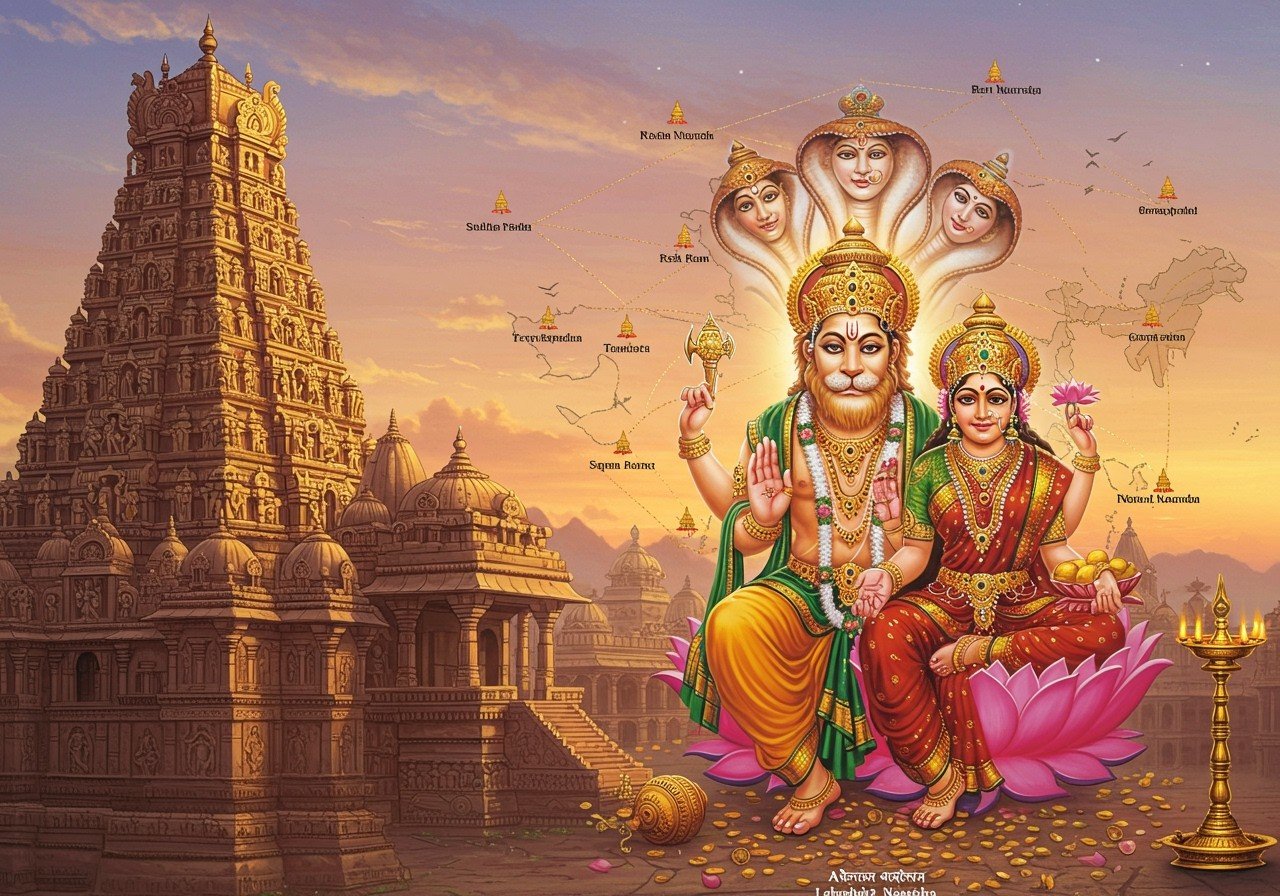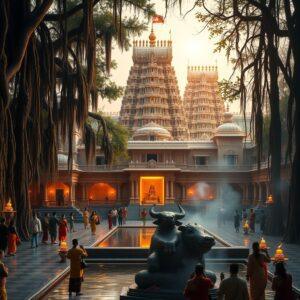
Journey through the rich tapestry of Indian culture and spirituality as we explore the magnificent Lakshmi Narasimha temples scattered across the country. Discover the captivating history, architectural brilliance, and profound spiritual significance of these sacred sites dedicated to Lord Narasimha, the awe-inspiring avatar of Lord Vishnu. This guide offers valuable insights into the traditions and authentic spiritual experiences that await, especially for culturally rooted Indians.
Historical Significance of Lakshmi Narasimha Temples
Lord Narasimha, the fierce half-lion, half-man incarnation of Vishnu, holds a pivotal role in Hindu mythology, and temples dedicated to him possess deep historical roots. Ancient texts and scriptures, including the Narasimha Purana, extol the significance of these temples, narrating the tale of the Lord’s divine intervention to protect his devotee Prahlada. Royal patronage from dynasties like the Cholas, Vijayanagar Kings, and Pallavas has ensured the construction and preservation of these architectural marvels through the ages. Many temples, like the Ahobilam temple complex, are associated with specific mythological events, further amplifying their historical importance within India’s cultural and religious landscape.
Architectural Marvels: A Symphony in Stone
Lakshmi Narasimha temples are renowned for their breathtaking architecture, each showcasing a unique blend of styles and influences:
- Ahobilam Temple (Andhra Pradesh): This complex boasts nine shrines dedicated to different forms of Narasimha, exhibiting the intricate Dravidian architectural style with towering gopurams and ornate carvings. The temple’s location amidst the Nallamala hills adds to its serene ambiance.
- Yadadri Narasimha Temple (Telangana): Perched atop a hillock, this temple showcases the grandeur of Vijayanagar architecture, featuring expansive courtyards, majestic gateways, and elaborate sculptures. The temple has recently undergone extensive renovations, enhancing its beauty and accessibility.
- Simhachalam Temple (Visakhapatnam): Known for its unique deity, the Varaha Lakshmi Narasimha Swamy, this temple’s architecture blends influences from the Kalinga and Dravidian styles. The idol is traditionally covered in sandalwood paste, revealing its true form only once a year.
- Lakshmi Narasimha Temple (Nuggehalli, Karnataka): A gem of Hoysala architecture, this temple is celebrated for its intricate carvings, star-shaped sanctum, and exquisite sculptures adorning its walls. The temple stands as a testament to the Hoysala’s mastery of stone carving.
The use of traditional materials and construction techniques has ensured the longevity and enduring beauty of these temples. Ongoing preservation and restoration efforts continue to protect these architectural wonders for generations to come.
Spiritual Practices and Rituals: Connecting with the Divine
Lakshmi Narasimha temples are vibrant centers of spiritual practice, observing a variety of rituals and traditions:
- Daily Puja (Worship): Daily rituals include abhishekam (ritual bathing of the deity), alankaram (adorning the deity with ornaments and garments), and naivedyam (offering of food). These practices create a sacred atmosphere and allow devotees to connect with the divine.
- Special Festivals: Narasimha Jayanti, commemorating the appearance of Lord Narasimha, is celebrated with great fervor, featuring special pujas, processions, and cultural performances. Other festivals like Vaikunta Ekadashi also draw large crowds of devotees.
- Role of Priests and Temple Staff: Priests play a vital role in conducting the daily rituals and maintaining the sanctity of the temple. Temple staff ensure the smooth functioning of the temple and assist devotees in their worship.
- Devotee Customs: Devotees offer specific prasadam (sacred food) and perform pradakshina (circumambulation of the sanctum) as part of their worship. Observing fasts and undertaking pilgrimages to these temples are considered highly meritorious.
Notable Lakshmi Narasimha Temples: A Pilgrimage Across India
India is home to numerous Lakshmi Narasimha temples, each with its own unique significance. Here are some of the most prominent:
- Ahobilam Temple Complex (Andhra Pradesh): Nestled in the Nallamala hills, this complex houses nine shrines dedicated to various forms of Narasimha, offering a diverse spiritual experience.
- Yadadri Narasimha Temple (Telangana): Recently renovated, this temple is a significant pilgrimage site, known for its stunning architecture and serene atmosphere.
- Simhachalam Temple (Visakhapatnam): Famous for its unique Varaha Lakshmi Narasimha Swamy deity, this temple attracts devotees from far and wide.
- Lakshmi Narasimha Temple (Sholingur, Tamil Nadu): Situated atop a hill, this temple offers panoramic views and a challenging yet rewarding climb for pilgrims.
- Mangalagiri Temple (Andhra Pradesh): This temple is revered for its self-manifested idol of Panakala Narasimha Swamy.
Beyond these well-known temples, lesser-known gems like the Lakshmi Narasimha temple in Hampi and the one in Bhadravathi, Karnataka, also hold great spiritual significance, offering unique glimpses into local traditions and beliefs. Poojn.in offers a wide selection of puja items specifically for Lord Narasimha, including stone Shivalingams and brass Trishuls.
Cultural and Social Impact: Temples as Community Hubs
Lakshmi Narasimha temples play a vital role in the cultural and social fabric of local communities. They serve as centers for cultural activities, hosting traditional music and dance performances, and promoting local arts and crafts through temple fairs and festivals. The economic impact of these temples is also significant, attracting pilgrims and tourists, which in turn supports local businesses. Temple trusts often engage in social service initiatives, providing education, healthcare, and support for the underprivileged.
These temples are instrumental in fostering community bonding and preserving cultural heritage, actively engaging younger generations in temple traditions and ensuring the continuity of these rich practices.
Travel Tips and Pilgrimage Information: Planning Your Visit
For devotees planning a pilgrimage to Lakshmi Narasimha temples, here are some helpful tips:
- Best Time to Visit: Research the weather conditions and festival dates to plan your visit accordingly. Summers can be hot in some regions, while festivals offer a vibrant but crowded experience.
- Travel Routes: Explore various modes of transportation, including road, rail, and air, to reach the temples. Check for local bus and taxi services for convenient travel within the area.
- Accommodations: Look for nearby accommodations, including dharamshalas (pilgrim guesthouses) and hotels, to suit your budget and preferences. Booking in advance, especially during festival seasons, is recommended.
- Local Guides: Consider hiring local guides for a more comprehensive pilgrimage experience. They can provide valuable insights into the temple’s history, rituals, and significance.
- Temple Etiquette: Dress modestly and respectfully when visiting temples. Adhere to the specific customs and traditions of each temple, such as removing footwear before entering the sanctum.
Pre-booking special pujas and darshans can help ensure a seamless and fulfilling experience at these sacred sites. You can find beautiful Laddu Gopal idols and Radha Krishna idols at Poojn.in to enhance your home worship experience.
Conclusion: Embrace the Spiritual Journey
Embark on a transformative spiritual journey through India’s revered Lakshmi Narasimha temples. Immerse yourself in the rich history, architectural splendor, and profound spiritual practices that these sacred sites offer. Each temple, with its unique traditions and significance, brings you closer to the divine presence of Lord Narasimha and deepens your connection to Indian cultural heritage. Whether you seek spiritual solace, historical enlightenment, or the sheer beauty of ancient architecture, visiting these temples will undoubtedly be an enriching and fulfilling experience. Plan your pilgrimage thoughtfully, respect the temple customs, and cherish the divine blessings of Lord Narasimha. May your journey be filled with peace, devotion, and spiritual growth.


